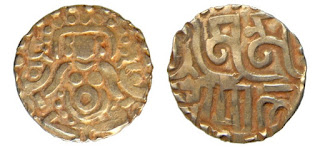The Pala Empire was a Buddhist Imperial power in Classical India during the 8th to 12th century AD. The empire was ruled by the Pala dynasty, all of whose rulers' names ended with the suffix Pala (protector). The Palas were described as Lords of Gauda. Their empire was centered around the present-day Bengal, Bihar region and included, at times, what are now Assam, Orissa, and parts of North India. The Palas ushered in a period of stability and prosperity in the Bengal region. They were followers of the Mahayana and Tantric schools of Buddhism.
Pagoda, Mahipala Deva, 988-1161 AD, gold, weight 4 gm.
The Pala Empire in the 9th century AD.The Pala rulers were promoters of classical philosophy, literature, painting and sculpture. They created many temples and works of art like Somapura Mahavihara, besides supporting the Universities of Nalanda and Vikramashila. The Proto-Bengali language developed under the Pala rule.
According to the Khalimpur copper plate inscription, the first Pala king Gopala was the son of a warrior named Vapyata. He came to power around 750 AD, after being elected by a group of regional chieftains. The Ramacharitam attests that Varendra (North Bengal) was the fatherland ( Janakabhu) of the Palas. Gopala's empire was greatly expanded by his son Dharmapala and his grandson Devapala. Dharmapala built a mighty empire in the northern India. He was succeeded by his son Devapala, who is regarded as the most powerful Pala ruler. His expeditions resulted in the invasion of Pragjyotisha (present day Assam) and the Utkala (present day Orissa). Whereas the king in Assam submitted without a fight, the Orissa king fled from his capital city.
Mahipala I recovered northern and eastern Bengal within three years of ascending the throne in 988 AD. He also gained control of north and south Bihar, probably aided by the invasions of Mahmud of Ghazni, which exhausted the strength of other rulers of north India. He may have also conquered Varanasi and the surrounding areas.
The empire thereafter again declined and again revived under Ramapala , though with limited success. He ruled from the new capital at Ramavati, which remained the Pala capital until the dynasty's end. After Ramapala's death, a rebellion broke out in Assam during his son Kumarapala's reign. Though the rebellion was crushed, but after Kumarapala's death, Vaidyadeva practically created a separate kingdom. According to Ramacharitam, Kumarapala's son Gopala III was murdered. Subsequently, the Varmans in east Bengal declared independence, and the Eastern Gangas renewed the conflict in Orissa. The Pala dynasty was replaced by the Sena dynasty in the 12th century. Govindapala was the last ruler of Pala dynasty. This marked the end of the last major Buddhist imperial power in the subcontinent.
The Pala period is considered as the Golden Ages in Bengal history. The empire enjoyed ties with the Srivijaya Empire, the Tibetan Empire and the Arab Abbasid Caliphate. Islam first came to Bengal during this period as a result of a rise in the commercial and intellectual contacts with the Middle East. Pala's legacy is still reflected in Tibetan Buddhism.
Coins of Pala Empire.
The Pala coins were designed on the coinage of the Pratiharas, which were imitations of Indo- Sassanian Coins. These coins were made in gold, silver and bronze. Some coins had Hindu deities inscribed on them.
Pagoda, Mahipala Deva, 988-1161 AD, gold, weight 4 gm, Obverse: Goddess Lakshmi seated in Padmashana facing, Reverse: Nagari legend in three lines, " Srimad Mahipala Deva."
















No comments:
Post a Comment
Any inputs or feedback is welcome!